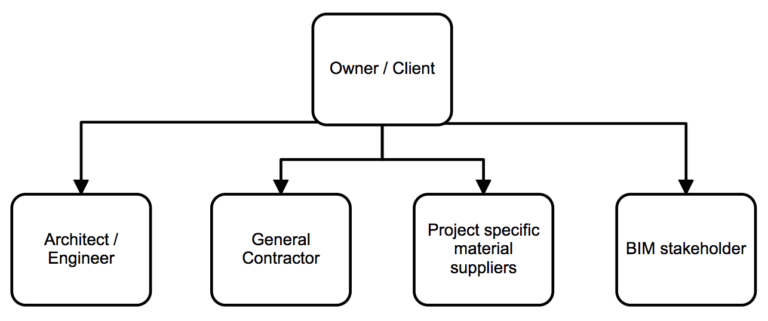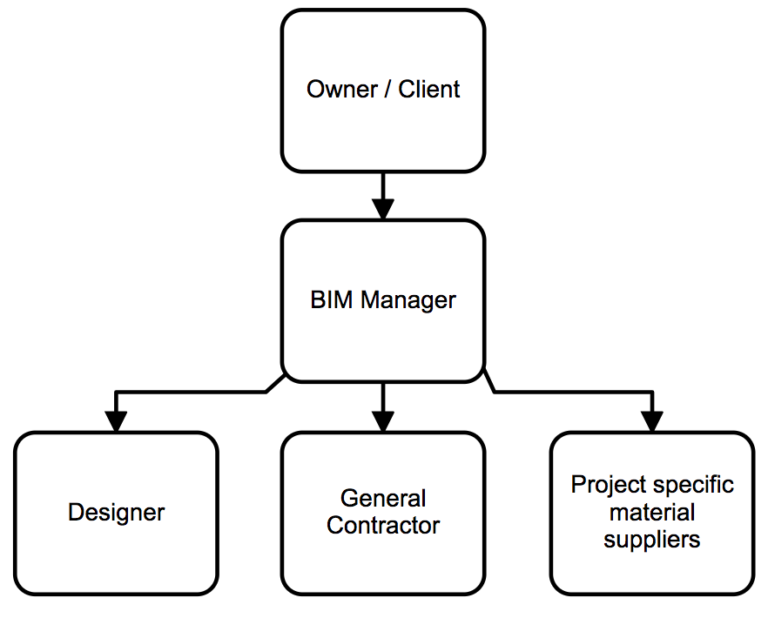Identifying the critical risk factors in a BIM enabled Indian EPC projects
TRADITIONAL EPC APPROACH IN BIM ENABLED ENVIIRONMENT. The Figure 1 explains the traditional model of EPC project model delivery, where even though BIM is implemented, the BIM related parties just function as another entity in the project and maintains its role and responsibility and report to the owner like general contractor. While the aim of BIM implementation is somewhat lost in a situation as stated in Figure 1.

The BIM should not only function as a tool, but as a method of collaboration between different AECO stakeholders to tackle several issues, such as design delays because of lack of co-ordination and drawing, clash detection, change management etc.
EPC APPROACH IN BIM ENABLED COLLABORATIVE ENVIIRONMENT. Let us have a look at Figure 2, in which the BIM managers takes supreme role after the owner to manage the stakeholders to ascertain the smooth flow of data and communication between all the involved parties. AIA, the American Institute of Architects had mandated the role of BIM manager in the BIM enabled projects.

Now in case of EPC projects, the project risk is almost completely shared to General Contractor, the project price also is generally higher than the cost of a same size of project if executed in DBB-Design Bid Build method, in which the risk is partially shared by Owner. while at a glance the risk to reward can sound a lucrative deal from general contractor’s perspective, risks if not properly dealt with can have a great impact in terms of cost & time.
BENEFITS AND STANDALONE RISKS. While implementing BIM technology and with pre-defined set of workflows can bring several benefits, there are some new standalone risks also being generated because of its implementation, different factors have role to play in such risks ranging from company internal management, local legal condition, financial capabilities etc. For example in the UK there is a contract framework like BIM protocol for all BIM maturity level 2.0 or higher level of BIM enabled project, while in India there is not yet any standard guidelines for BIM enabled projects.
Further, one of the prime factors to consider for BIM even before initiating the project is probably the organisational culture, whether BIM will be adopted, based on literature review it is found out that most of experienced managers are not in favour of implementing BIM in their projects, keeping in mind the high cost of BIM software, hardware and also in terms of training the employees to work in a new platform. Because most of real estate or contracting organisations in India are hierarchical, signifying it follows a top-down management approach, adoption of BIM in project can be in great question.
There are other technological risks as well, how the designer can maintain “standard of care” in the model while compute generates some model by its own in terms of pre-loaded data, also BIM contains multiple files and libraries, if some amendment is done in a file in a certain library by third party like MEP contractor without the knowledge of other stakeholders, what can be the implication and what to do about it. It is quite evident that risk management in a new way of working in BIM environment becomes of paramount importance.
CONCLUSION. EPC projects has its own set of risk in terms of technical, legal, financial and regulation related risk, some can be tackled care in BIM environment, while BIM brings a new set of risk, therefore a thorough risk analysis needs to be done to create a benchmark of the risks that a BIM manager should be aware of and subsequent to get a prior insight.
NEED YOUR FEEDBACK. To facilitate the industry practitioners, a new research is being conducted to ascertain the priority of different risk factors, and subsequently finding the critical risk factors and how to deal with it. I request your feedback on the research objective, also kindly contribute with your valuable response in the survey. Whether you’re designer, owner or general contractor any role, who is associated with BIM/EPC projects in some way or another is requested to participate.
REFERENCES.
- Chong, Heap-Yih, Su-Ling Fan, Monty Sutrisna, Shang-Hsien Hsieh, and Ching-Mei Tsai. “Preliminary Contractual Framework for BIM-Enabled Projects.” Journal of Construction Engineering and Management 143, no. 7 (2017): 04017025.
- Nanajkar, Aarti, and Zhili Gao. “BIM Implementation Practices at India’s AEC Firms.” In ICCREM 2014: Smart Construction and Management in the Context of New Technology, pp. 134-139. 2014.
- Amarnath CB. “BIM Implementation in India”. India BIM Association blog post. 10th Sep 2017. URL: http://ibima.co.in/2017/09/10/bim-implementation-india/
- Sawhney, A., A. Kapoor, S. Kamthan, N. Agarwal, P. Bhakre, and S. Jain. “State of BIM adoption and outlook in India.” RICS school of built environment, Amity University (2014).
ACKNOWLEDGEMENTS
I like to thank Amarnath CB for supporting me in the process of data collection and proof reading my research article. And, like to thank India BIM Association and its Active members for their constant support.
GUEST AUTHOR
Pallab Goswami is basically a Civil Engineer. He is currently pursuing Master Degree in Project Management at Tsinghua University. He is a Active Member of India BIM Association. He has served at Larsen and Toubro for six years as Assistant Manager (3 years), Senior Civil Engineer (2 years) and as Graduate Civil Engineering trainee (1 year).
Pallab is a Construction Management professional with over six years of experience in Vendor Management, Customer Relationship Management, Cost Optimization Site Procurement , Contract Management, Materials Management. You can contact Pallab Goswami through LinkedIn / Email / Mobile. +86-18801381178
Source: http://ibima.co.in/2018/03/13/identifying-critical-risk-factors-bim-enabled-indian-epc-projects/












